The tenth anniversary of the discovery of gravitational waves confirms Stephen Hawking’s black hole area theorem
- Scientific Culture and Innovation Unit
- Marketing and Communication Service
- September 10th, 2025

The international collaborations LIGO, Virgo – in which the University of Valencia (UV) takes part – and KAGRA are celebrating the tenth anniversary of the first detection of gravitational waves and have announced the confirmation of Stephen Hawking’s black hole area theorem. This important result is discussed in an article published today in Physical Review Letters.
Over the past decade there has been a spectacular increase in gravitational-wave discoveries by the LIGO-Virgo-KAGRA network, amounting to more than 300 black hole mergers, most of which have already been confirmed. While the observed signals come mainly from collisions of stellar-mass black holes, the first observations of neutron star collisions, mergers between a neutron star and a black hole and asymmetric mergers – in which a black hole is significantly more massive than the secondary compact object – have also been achieved.
“The multiple detections of gravitational waves carried out over the past decade have revealed the existence of new populations of binary compact object systems. Our analyses of black hole mergers are allowing us to explore the strong and dynamic gravitational-field regime and to test the limits of Einstein’s theory of general relativity and its paradigmatic predictions”, explains José Antonio Font, professor in the Department of Astronomy and Astrophysics (UV) and coordinator of the Virgo group in Valencia.
“It is fascinating that these gravitational-wave signals allow us to test our understanding of gravity. It has been a wonderful 10 years since the first direct detection, and the future is simply brilliant. Next week an event will be held in Mallorca to celebrate this anniversary with the participation of the Virgo group in Valencia”, notes Isabel Cordero, researcher in the Department of Mathematics at the UV and head of outreach for Virgo-Valencia.
On 14 September 2015, a signal reached Earth carrying information about a pair of distant black holes that had spiralled together and merged. The signal had travelled around 1.3 billion years to reach us at the speed of light — but it was not made of light. It was another kind of signal: a tremor of space-time known as gravitational waves, first predicted by Albert Einstein a century earlier. On that day, ten years ago, the twin detectors of the Laser Interferometer Gravitational-Wave Observatory (LIGO) made the first direct detection of gravitational waves. LIGO and Virgo collaborations announced the finding to the world in February 2016, after six months of analysis and verification.
This historic discovery meant that researchers could now begin to observe the universe through three different channels. Light waves — X-rays, visible light, radio waves and other wavelengths — had already been detected, as well as high-energy particles called cosmic rays and neutrinos. This was the first time that the scientific community had witnessed a cosmic event through the gravitational distortion of space-time. For this achievement, dreamed of more than forty years earlier, three of LIGO’s founders — Rainer Weiss, Barry Barish and Kip Thorne — were awarded the 2017 Nobel Prize in Physics.
Improved instrument sensitivity has been demonstrated in a recent discovery: the black hole merger designated GW250114 (14 January 2025). By analysing the frequencies of the gravitational waves emitted during the merger, the LIGO-Virgo-KAGRA (LVK) collaboration obtained the best observational evidence to date of Stephen Hawking’s black hole area theorem, proposed in 1971. The theorem states that the total surface area of black holes cannot decrease. When black holes merge, their masses combine and, therefore, the surface area increases. However, the merger process also radiates energy in the form of gravitational waves and may increase the rotation speed of the resulting black hole, which could lead to a reduction in its area. Hawking’s theorem asserts that, although these effects compete, the total area must grow.
The most challenging part of this type of analysis was determining the final surface area of the merged black hole. In the new study, the researchers were able to accurately measure the details of the relaxation phase, allowing them to calculate the mass and spin of the black hole and, subsequently, determine its surface area. More specifically, they were able, for the first time, to reliably identify two distinct modes of gravitational waves in the relaxation phase. The improvement in the GW250114 data enabled the team to extract the modes, demonstrating that the black hole’s relaxation occurred exactly as predicted by mathematical models.
Another LVK study, submitted today to Physical Review Letters, sets limits on a third, higher-pitched tone predicted in the GW250114 signal and performs some of the most rigorous tests to date of the accuracy of general relativity in describing black hole mergers.
The LIGO-Virgo-KAGRA Collaboration
LIGO, Virgo and KAGRA operate in coordination and currently detect roughly one black hole merger every three days. Altogether, the LVK gravitational-wave search network has recorded over 300 black hole mergers, most already confirmed, with others awaiting more detailed analysis. During the network’s current observation run — its fourth since the first in 2015 — LVK has discovered around 230 candidate black hole mergers, more than double the number recorded in the first three runs.
LIGO is funded by the NSF (National Science Foundation, USA) and managed by Caltech and MIT, which jointly conceived and built the project. The Virgo Collaboration currently consists of around 1,000 members from 175 institutions in 20 different countries (mainly European). KAGRA is a laser interferometer with 3-kilometre-long arms located in Kamioka, Gifu (Japan). The host institution is the Institute for Cosmic Ray Research (ICRR) at the University of Tokyo.















